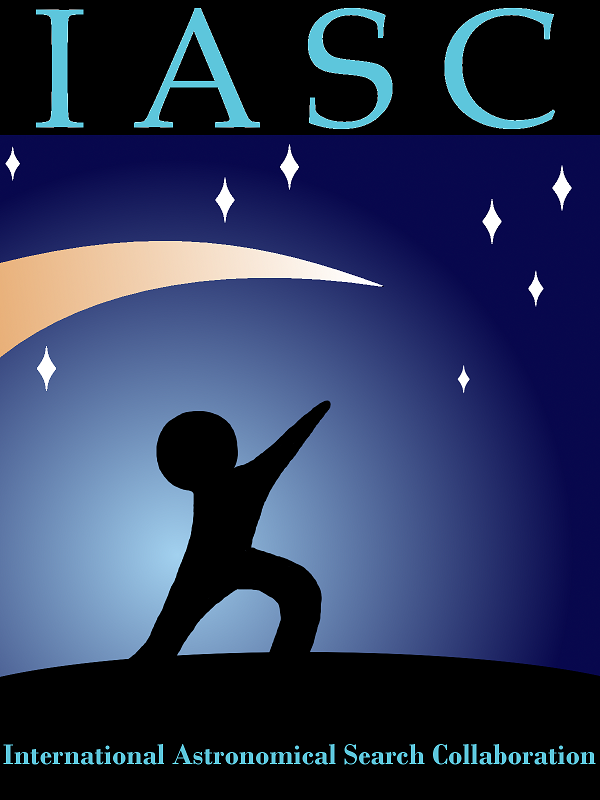Announcement: We have a new email address! Please direct all emails to: iascsearch@cisco.edu

Thank you for your interest in IASC! We would love for you and your citizen science group to participate.
Getting involved is simple!
Teams should consist of at least two team members. If you need assistance forming a group,
we can connect you with other participants in your area.
You need access to a Windows computer.
You need an Internet connection.
Your team should pick a campaign
from our website that fits into your schedule. Please see below for all of the available search campaigns.
Some campaigns other than the International Asteroid Search Campaign are coordinated by our collaborators.
If you want to register for one of these campaigns you may need to contact the organization specified
in the campaign name.
To register, fill out the form provided in the link below. Be advised it may take a few days for IASC to process your registration request.
Asteroid search campaigns are run and managed by the International Astronomical Search Collaboration (IASC = “Isaac”). Each year around 5,500 teams participate from more than 80 countries. Participants make important detections of Main Belt asteroids (MBAs) and occasionally of trans-Neptunian objects (TNOs).
Since the first campaign in October 2006, IASC participants have made over 3,900 asteroid discoveries. To date 76 have been numbered and placed into the world’s official minor bodies catalog maintained by the International Astronomical Union (IAU, Paris). These discoveries can be found on the Hall of Fame page on the IASC website. Once an asteroid discovery has been numbered, it can be named by its discoverers.
Image sets for general asteroid search campaigns are provided by the Institute for Astronomy (IfA) at the University of Hawaii. Given clear and dark skies, the IfA uses the 1.8-m Pan-STARRS telescope located on Haleakalā to take images along the ecliptic where most asteroids are found. For special campaigns with experienced teams, image sets may be provided by the Catalina Sky Survey (CSS) at the University of Arizona.
Teams receive these image sets through the IASC website and use the program Astrometrica to search for and measure asteroids. A report is prepared in Astrometrica and submitted through the IASC website to be reviewed for possible detections. Reports must not be sent to any other location.
| Start Date | End Date | Campaign Name |
| Monday, January 12, 2026 | Friday, February 6, 2026 | All Israel Asteroid Search Campaign |
| Monday, January 12, 2026 | Friday, February 6, 2026 | All Nepal Asteroid Search Campaign |
| Monday, January 12, 2026 | Friday, February 6, 2026 | All Turkey Asteroid Search Campaign |
| Monday, January 12, 2026 | Friday, February 6, 2026 | Canary Islands Asteroid Search Campaign |
| Monday, January 12, 2026 | Friday, February 6, 2026 | Astrophile Asteroid Search Campaign |
| Monday, January 12, 2026 | Friday, February 6, 2026 | CB Devgun Memorial Asteroid Search Campaign |
| Monday, January 12, 2026 | Friday, February 6, 2026 | China Skywatcher Asteroid Search Campaign |
| Monday, January 12, 2026 | Friday, February 6, 2026 | Hands-On Universe India Asteroid Search Campaign |
| Monday, January 12, 2026 | Friday, February 6, 2026 | Haus der Astronomie Asteroid Search Campaign |
| Monday, January 12, 2026 | Friday, February 6, 2026 | MARSG India - SA Citizen Science Group Asteroid Search Campaign |
| Monday, January 12, 2026 | Friday, February 6, 2026 | Navars Asteroid Search Campaign |
| Monday, January 12, 2026 | Friday, February 6, 2026 | NUCLIO Asteroid Search Campaign |
| Monday, January 12, 2026 | Friday, February 6, 2026 | Pan-Africa Asteroid Search Campaign |
| Monday, January 12, 2026 | Friday, February 6, 2026 | Saptarishi India Asteroid Search Campaign |
| Monday, January 12, 2026 | Friday, February 6, 2026 | Smartcircuits Innovation Asteroid Search Campaign |
| Monday, January 12, 2026 | Friday, February 6, 2026 | StAnD Erasmus+ Asteroid Search Campaign |
| Monday, January 12, 2026 | Friday, February 6, 2026 | STEM & Space Asteroid Search Campaign |
| Monday, January 12, 2026 | Friday, February 6, 2026 | TSCM Asteroid Search Campaign |